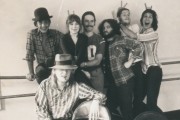 “The biggest movies in the world have no stars in them today. Avatar has no stars. Avengers, with the exception of the small role that Robert Downey, Jr. had in it, had no stars. Today it is the story not the stars.”
“The biggest movies in the world have no stars in them today. Avatar has no stars. Avengers, with the exception of the small role that Robert Downey, Jr. had in it, had no stars. Today it is the story not the stars.”
-David Geffen, “American Masters: Inventing David Geffen”
John Wayne, perhaps the most iconic American actor, was considered one of the biggest box office attractions from the early 1940s until his death in 1976, a staggering thirty-plus year run. There isn’t any actor in history who comes close to that longevity, although there have certainly been big stars since the Duke finally rode off into the sunset. In earlier decades, many moviegoers went to go see movies with their favorite stars in them, which perhaps explains why someone as charismatic as Elvis Presley was able to make so many awful, yet financially successful, movies – the audience wasn’t there to see a good movie, they were there to see Elvis.
But it’s interesting to note that many people who are thought of as Hollywood’s biggest current stars aren’t packing the theaters like their earlier counterparts. For example, Johnny Depp is widely considered one of the biggest stars today, yet three of his recent films (Dark Shadows, The Rum Diary, and The Tourist) underperformed at the domestic box office, with the latter being the biggest surprise since it also starred Angelina Jolie, one of the biggest contemporary female stars (although to be fair, both Dark Shadows and The Tourist did much better business overseas). Tom Hanks also remains incredibly popular from his reign as the king of the box office in the 1990s, but two of his recent films (Larry Crowne, Extremely Loud & Incredibly Close) went over like an unwanted surprise party, and Cloud Atlas has so far been a financial disaster. Robert Downey, Jr. might take the cake as the most recent bankable star (he has the Iron Man movies, the Sherlock Holmes movies, Due Date, and Tropic Thunder to his credit), but his current five-year reign is nothing in comparison to the much-longer reigns of yesteryear. Even Will Smith, one of the most consistent performers in Hollywood throughout the late 1990s and 2000s, can’t really be considered a box office champ when he now appears to be taking several years off between each movie. It wouldn’t be surprising if his popularity eventually petered out like one-time stars Mike Myers and Eddie Murphy, who only seem to have a hit these days if it is an animated movie (and Hanks is dangerously close to joining that group). Unfortunately actresses are a bit harder to peg. It’s rare that stars like Angelina Jolie, Julia Roberts, Cameron Diaz, or Sandra Bullock appear in their “own” films as much of their work are romantic comedies and they’re frequently opposite an equally or nearly equally as popular male co-star, and those movies rarely do blockbuster ($100 million+) numbers.
Movie stardom seems rather fleeting these days, and I have to agree with David Geffen‘s quote that it seems to matter little in the context of a movie’s success. After all, Geffen — the co-founder of Dreamworks — is correct: of the all-time highest grossing films you won’t find many “A-list” names among the cast list. Avatar was devoid of stars — with the lead, Sam Worthington, a virtual unknown at the time of the film’s shooting, and Titanic had only Leonardo DiCaprio, who at the time was a teen heartthrob rather than the respected actor he is today, and Kate Winslet is a bigger, respected name now but certainly not a superstar (and a virtual unknown in the United States before Titanic). As Geffen points out, The Avengers boasted Downey (though I think he ought to have thrown in a mention of the popular Scarlett Johansson and Samuel L. Jackson, too). And if you recall, the casting of Heath Ledger as the Joker in The Dark Knight was initially met with a collective “What? The guy from 10 Things I Hate About You?” from most audiences, something that we’d all like to forget now that his brilliant performance proved us all wrong (though there weren’t any blockbuster icons among the rest of the cast, either). The next two films on the list — Star Wars Episode I and the original Star Wars — both feature actors who really didn’t become recognizable until after the films were released, with a handful of respected actors (Alec Guinness, Liam Neeson), but not exactly box office stars.
When one looks at the recent popularity in genre fiction adaptations, it’s clear that story is definitely more important than stars. The Lord of the Rings trilogy and The Hobbit don’t feature many stars, and the entire adult cast of the Harry Potter films remain far more popular in England than in America. Neither The Hunger Games nor Twilight have any stars, either, yet all of those films are among the highest grossing in the last decade. It’s worth noting that since so many of these genre fiction films have large casts and huge special effects budgets it’s financially impossible to cast even two or three $15 million dollar actors in a single film. Because of that, movie success these days now seems to be so much more about the story and the storyteller – notice how only a handful of directors were well known in the “star” era, yet it’s common for even the casual moviegoer to know the names of a dozen top directors today. Heck, we’re getting to the point where talented screenwriters are a drawing card for audiences.
Have we seen a gradual shift in drawing power from stars to filmmakers in Hollywood over the last three decades? I think that’s fair to say considering how many directors, producers, and screenwriters have become common names among film fans. While there will always be a place for stars in the industry, a more prominent place for the behind-the-scenes artists is entirely welcome.















Recent Comments